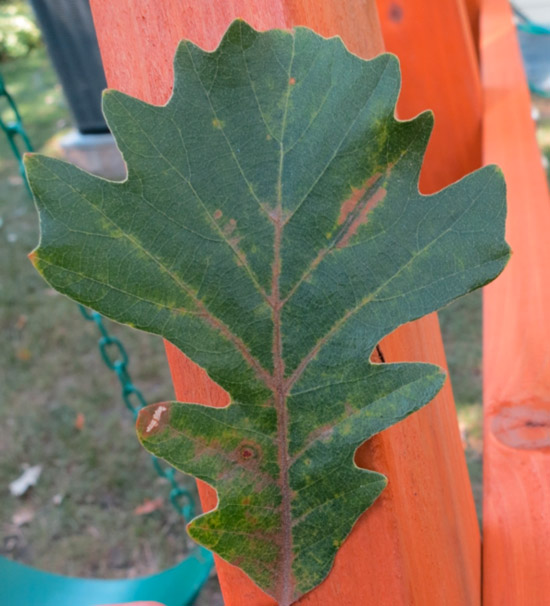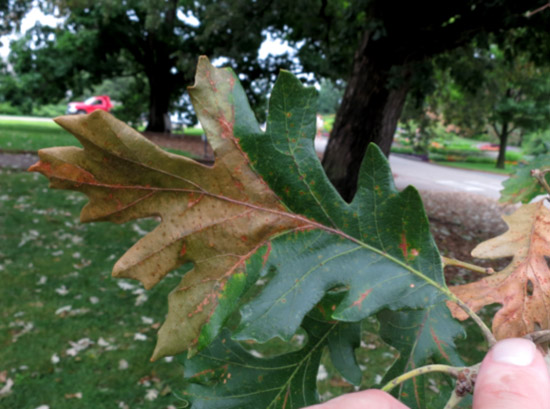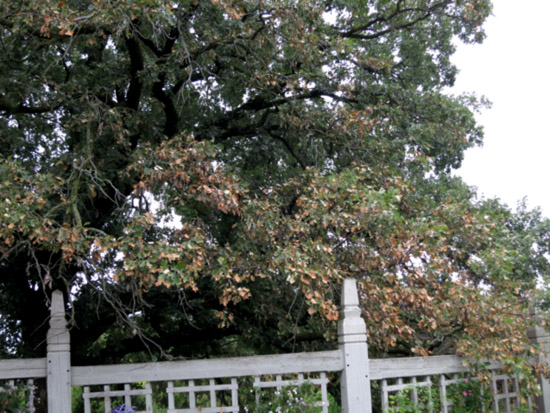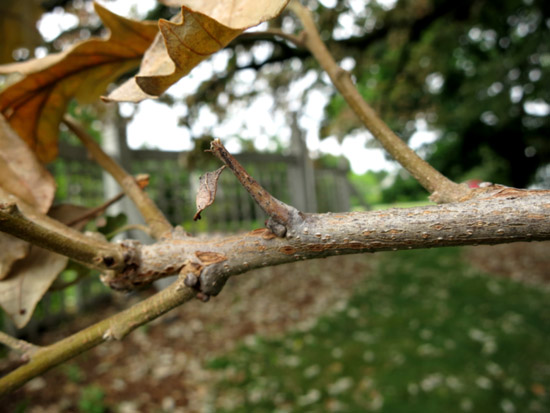Issue 15, September 9, 2013
Bur Oak Blight
Last summer, the U of I Plant Clinic confirmed its first sample of Bur Oak Blight (BOB). The infected tree was located in Lake County, IL. Dr. Tom Harrington of Iowa State University and his research lab have been keeping track of counties and states with trees confirmed to have BOB. As of January 2013, seven counties in Illinois have had confirmed BOB cases. The majority of these counties are located in the northern portion of the state along the Wisconsin state line. A map with the current disease distribution can be found here.
Bur Oak Blight is a fungal disease caused by a newly described pathogen, Tubakia iownesis. Several species of Tubakia are known to infect oak (Quercus spp.) and cause minor leaf spots. Tubakia iowensis is the only species known to cause severe leaf blight, and will only infect Bur oak (Quercus macrocarpa). Fortunately, susceptibility to this disease varies within Bur oak populations. Highly resistant Bur oak trees have been observed growing in close proximity to trees severely infected with BOB. The variety Quercus macrocarpa var. oliviformis has been reported to be especially susceptible to the disease.
Symptoms
The earliest symptoms of Bur Oak Blight first appear in June as purple-brown spots on the underside leaf veins. In July, the spots expand, and purplish necrotic veins become noticeable on the upper leaf surface (first image). Leaf veins are killed as the infection progresses and a characteristic wedge shaped necrotic area develops on the leaf blade (second image). Coalescing lesions and expanding vein necrosis may cause the leaf to die. Severely affected trees may have significant leaf mortality and/or leaves with a scorched appearance (third image). Many, but not all, leaves killed by BOB remain attached to the tree into the winter, well after healthy Bur oaks have dropped their leaves.
The retention of diseased leaves favors the pathogen and its spread. This pathogen over-winters as pustules on the diseased leaf petioles that remain attached to the tree. In late April and May, fungal spores are produced and released from the pustules about the same time as new leaves are developing and expanding. Heavy rainfall promotes spore production and disseminates this primary inoculum by splashing the spores to newly expanding leaves. Infection occurs before the leaves are fully developed. However, there is a latent period between infection and when the first symptoms appear in June.
Initially, infections may be limited to the lower branches. Symptoms intensify from year to year and progress from the lower branches to the entire crown.

Purple-brown necrotic veins on the upper leaf surface associated with Bur Oak Blight

Wedge-shape lesion characteristic of Bur Oak Blight

Bur oak with lower canopy affected by Bur Oak Blight
Diseased leaf retention is currently one of the best ways to identify this disease in the field. Look for leaves and petioles attached from the previous growing season. Infected petioles will have black pustules or scars from previously attached pustules (fourth image). The other species of Tubakia that infect Bur oak are not known to produce these overwintering pustules.
Several successive years of severe infection and defoliation have been reported to kill trees. Death has also been attributed to secondary invaders such as the twolined chestnut borer. Trees infected with BOB appear to have increased susceptibility to these secondary invaders.

Branch with diseased petiole still attached from previous growing season. Note the small black pustules.
Management Strategies
- If you suspect a BOB infection, have the disease diagnosis confirmed by a laboratory. The leaf blight and scorching symptoms of BOB can be confused with oak wilt, oak anthracnose, and environmental stresses. Disease confirmation is important for providing accurate disease control strategies and recommendations. Suspect BOB samples can be submitted to the University of Illinois Plant Clinic. Information on general sample submission can be found on the plant clinic website. A $15 fee will cover diagnostic services for the sample. For Bur Oak Blight sampling, collect branches and twigs with symptomatic and healthy leaves. Be sure to include branches with petioles from the previous growing season still attached (see fourth image for example)
- Raking diseased leaves may have little effect on controlling the disease. The primary infection occurs from the abundant spores produced from diseased petioles that remain attached to the tree.
- Boosting tree vigor may help the tree to limit and prevent secondary invaders. Pruning and removing branch dieback has been suggested to help reduce borer populations
- For high value trees, Iowa State University found trunk injections of propiconazole to be effective at controlling the disease. Applications require specialized equipment and will need to be made by a certified professional.
- Injections should be made in late May or early June just after the leaves have fully expanded
- The recommended application rate is 8-10 mls per 1"DBH. Higher applications rates reportedly resulted in phytotoxicity to leaves. The rate will also need to be adjusted if the tree has significant branch dieback in the canopy.
- One application should last several years. Iowa State currently recommends repeat application only after a severe outbreak recurs.
References and Further Reading
US Forest Service Pest Alert: Bur Oak Blight (Adobe PDF)
Published Research Article-- Harrington T, McNew D, Hye Young Y. Bur oak blight, a new disease on Quercus macrocarpa caused by Tubakia iowensis sp. nov. Mycologia January 2012;104(1):79-92.
(Travis Cleveland)
Author:
Travis Cleveland